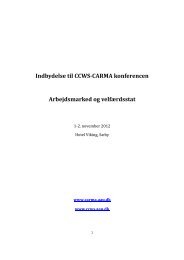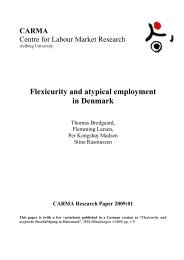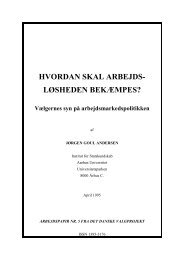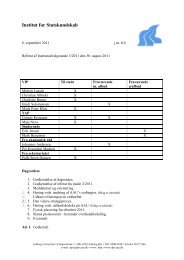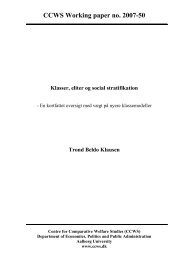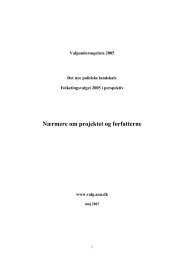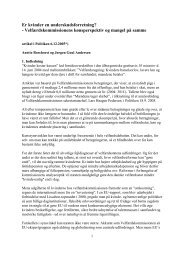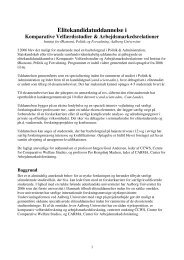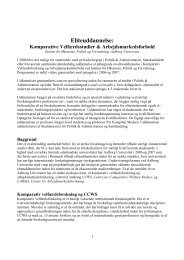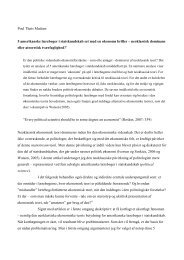Ageing and welfare reform in the Nordic Countries, 1990-2010 ...
Ageing and welfare reform in the Nordic Countries, 1990-2010 ...
Ageing and welfare reform in the Nordic Countries, 1990-2010 ...
You also want an ePaper? Increase the reach of your titles
YUMPU automatically turns print PDFs into web optimized ePapers that Google loves.
equivalent to a m<strong>and</strong>atory system by hav<strong>in</strong>g <strong>the</strong> state foot <strong>the</strong> bill– <strong>and</strong> subsequently by mak<strong>in</strong>gbenefits more generous <strong>in</strong> terms of compensation <strong>and</strong> duration. 20After 2000, this development was reversed <strong>in</strong> Denmark <strong>and</strong> Sweden by <strong>in</strong>creas<strong>in</strong>g members’contributions. Much of this was carried through <strong>in</strong>directly <strong>and</strong> tacitly, via reduc<strong>in</strong>g or ab<strong>and</strong>on<strong>in</strong>gtax deductions. In Sweden, members’ contributions also became dependent on unemployment risk,<strong>and</strong> benefits became far less generous. In both countries, benefits became <strong>in</strong>creas<strong>in</strong>gly conditionalon work & mobility requirements. In Sweden 2007-08, it became impossible to reqalify for benefitsthrough activation, <strong>and</strong> <strong>the</strong> compensation rate was reduced <strong>and</strong> related to duration of benefits 21which was reduced to 300 days, with possibility of 300 more days on a reduced benefit. On thisbackground, it is hardly an exaggeration to speak of a re-commodification <strong>and</strong> a privatization ofsocial risk. “Systemic retrenchment” was also <strong>in</strong>volved as unions were weakened.In Denmark <strong>the</strong> “flexicurity” system was jeopardized by an unexpected redution of duration ofbenefits to only two years <strong>in</strong> <strong>2010</strong>. As a response, wage earners claimed more employmentprotection <strong>in</strong> collective agreements. Consider<strong>in</strong>g retrenchment elsewhere, duration of two years isnot exceptionally bad. But duration was <strong>the</strong> ma<strong>in</strong> “security” component of Danish “flexicurity” –<strong>the</strong> so-called golden triangle of liberal employment protection, generous security for <strong>the</strong>unemployed, <strong>and</strong> activation to br<strong>in</strong>g people back to work (Madsen, 2002). This <strong>in</strong>stitutionalcomplementarity was nearly ab<strong>and</strong>oned over night. So far, it is difficult to guess about effects (DetØkonomiske Råd 2009a; Nørgaard 2009), but <strong>the</strong> Danish <strong>and</strong> Swedish <strong>reform</strong>s do representsignificant <strong>in</strong>stances of re-commodification, <strong>and</strong> if <strong>the</strong> economic recession cont<strong>in</strong>ues as expected, itwill have a significant social impact <strong>in</strong> both countries.Tax <strong>reform</strong>sF<strong>in</strong>ally, most countries have sought to reduce taxes on labour <strong>in</strong> order to stimulate labour marketparticipation. Whe<strong>the</strong>r it works it rema<strong>in</strong>s contested. From <strong>the</strong> <strong>1990</strong>s, a concern for globalcompetitiveness pulled <strong>in</strong> <strong>the</strong> same direction – ma<strong>in</strong>ly aimed at reduc<strong>in</strong>g corporate taxes but alsotaxes on labour. As far as taxes on labour is concerned, empirical analyses have never been able tovalidate tax flight (Velfærdskommissionen, 2005; Pedersen, Røed & Schröder, 2003).Whereas <strong>the</strong> labour supply argument addresses marg<strong>in</strong>al taxes, migration <strong>in</strong>centives are aboutaverage taxes, <strong>and</strong> about <strong>the</strong> sum of all taxes – or ra<strong>the</strong>r: about <strong>the</strong> sum of all taxes plus”necessary” social expenditures. Consider<strong>in</strong>g that mobility across borders is found ma<strong>in</strong>ly among<strong>the</strong> young – who will have children sooner or later – <strong>the</strong> important question is how economic<strong>in</strong>centives look for this target group. With large subsidies for high-quality child care, <strong>the</strong> <strong>Nordic</strong>countries appear highly competitive <strong>in</strong> this respect: Few people <strong>in</strong> <strong>the</strong> relevant taget group wouldhave economic <strong>in</strong>centives to emigrate from <strong>the</strong> <strong>Nordic</strong> region.As regards taxation of wages, <strong>Nordic</strong> countries are not high tax countries anymore. This holds both20 Accord<strong>in</strong>g to Roed (1999) members f<strong>in</strong>anced only some 20 per cent of <strong>the</strong> costs <strong>in</strong> Denmark, <strong>and</strong> about 5 per cent <strong>in</strong>Sweden <strong>and</strong> F<strong>in</strong>l<strong>and</strong> at that time.21 People with children under 18 ma<strong>in</strong>ta<strong>in</strong> 70 per cent for addditional 30 weeks.16



